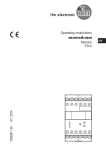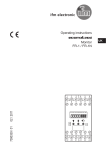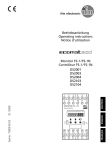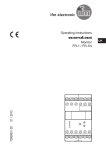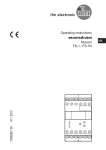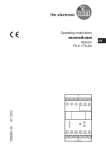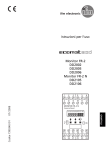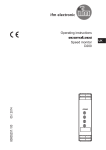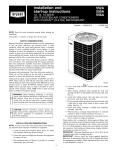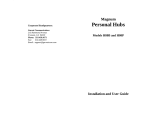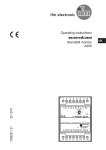Download Operating instructions Monitor FD-2 DR2005
Transcript
Operating instructions Monitor FD-2 UK DR2005 DR2006 7390342 / 01 07 / 2007 Content 1 Safety instructions�����������������������������������������������������������������������������������������������4 2 Functions and features����������������������������������������������������������������������������������������6 2.1 Example IN1 before IN2��������������������������������������������������������������������������������6 2.2 Example IN2 before IN1��������������������������������������������������������������������������������7 3 Operating principle����������������������������������������������������������������������������������������������8 4 Operating and display elements��������������������������������������������������������������������������9 5 Installation���������������������������������������������������������������������������������������������������������10 5.1 Mounting of the sensors:�����������������������������������������������������������������������������10 6 Electrical connection������������������������������������������������������������������������������������������ 11 6.1 Terminal connection������������������������������������������������������������������������������������� 11 6.2 Voltage supply (power)�������������������������������������������������������������������������������� 11 6.3 Connection of the sensors (In1, 2)��������������������������������������������������������������12 6.4 Input reset 1/2����������������������������������������������������������������������������������������������12 6.5 Load circuits relay outputs (Out1, 2)������������������������������������������������������������12 6.6 Load circuits transistor outputs (Out1, 2)�����������������������������������������������������13 6.7 Typical input circuit��������������������������������������������������������������������������������������13 7 Navigation and parameter overview������������������������������������������������������������������14 7.1 System parameters�������������������������������������������������������������������������������������15 7.1.1 SOx�����������������������������������������������������������������������������������������������������15 7.1.2 ST1�����������������������������������������������������������������������������������������������������15 7.1.3 SC1�����������������������������������������������������������������������������������������������������15 7.1.4 FP1�����������������������������������������������������������������������������������������������������17 7.1.5 NC1����������������������������������������������������������������������������������������������������17 7.1.6 EVM����������������������������������������������������������������������������������������������������17 7.1.7 DIM�����������������������������������������������������������������������������������������������������18 7.1.8 VER����������������������������������������������������������������������������������������������������18 7.2 Application parameters��������������������������������������������������������������������������������19 7.2.1 CTx�����������������������������������������������������������������������������������������������������19 7.2.2 DTx�����������������������������������������������������������������������������������������������������19 7.2.3 FTx�����������������������������������������������������������������������������������������������������19 8 Programming�����������������������������������������������������������������������������������������������������20 8.1 Programming example DT2 (delay time, output 2)��������������������������������������21 8.2 Notes on programming��������������������������������������������������������������������������������22 2 8.2.1 RUN mode������������������������������������������������������������������������������������������22 8.2.2 Time-out function��������������������������������������������������������������������������������22 8.2.3 Numerical entries��������������������������������������������������������������������������������22 8.2.4 Factory Reset�������������������������������������������������������������������������������������22 8.2.5 KEY function���������������������������������������������������������������������������������������23 9 Technical data����������������������������������������������������������������������������������������������������24 10 Scale drawing��������������������������������������������������������������������������������������������������26 11 Maintenance, repair, disposal��������������������������������������������������������������������������26 3 UK These instructions apply to all units of the monitor type FD-2. They are intended for authorised persons according to the EMC and low voltage directives. They are part of the unit. They contain information about the correct handling of the product. Read them before use to familiarise yourself with operating conditions, installation and operation. Follow the safety instructions. 1 Safety instructions Follow the operating instructions. Non-observance of the instructions, operation which is not in accordance with use as prescribed below, wrong installation or incorrect handling can affect the safety of operators and machinery. The installation and connection must comply with the applicable national and international standards. Responsibility lies with the person installing the device. The unit must only be installed, connected and put into operation by a qualified electrician as • during the installation dangerous contact voltage occurs and • the safe function of the unit and the plant is only guaranteed when installation is correctly carried out. Disconnect the unit externally before handling it. Also disconnect any independently supplied relay load circuits. Be careful when handling the unit once power is applied. This is only allowed by qualified personnel due to the protection rating IP 20. The design of the unit corresponds to the protection class II except for the terminal blocks. Protection against accidental contact (finger-touch to IP 20) for qualified personnel is only guaranteed if the terminal screw has been completely screwed in. For the correct operation the unit must be mounted in a housing (protection rating IP 40 or higher) which can only be opened using a tool or in a locked control cabinet. If the unit has an external 24 V DC supply, this voltage must be generated and supplied externally according to the requirements for safe extra-low voltage (SELV) since this voltage is supplied without further measures near the operating elements and at the terminals for the supply of connected pulse pick-ups. The wiring of all signals in connection with the SELV circuit of the device must also comply with the SELV criteria (safety extra-low voltage, safe electrical isolation from other electric circuits). 4 If the externally supplied or internally generated SELV voltage is externally grounded, the responsibility lies with the user in accordance with the applicable national installation regulations. All statements in these operating instructions refer to the unit the SELV voltage of which is not grounded. It is not allowed to supply external voltage to the terminals for the pulse pick-up supply. The consumption of current which exceeds the value given in the technical data is not allowed. An external main switch must be installed for the unit which can switch off the unit UK and all related circuits. This main switch must be clearly assigned to the unit. As described in the technical specifications below the device can be operated in a wide ambient temperature range. Because of the additional internal heating the operating elements and the housing walls can have high perceptible temperatures when touched in hot environments. In case of malfunction of the unit or queries please contact the manufacturer. Any tampering with the device can seriously affect the safety of operators and machinery. This is not permitted and leads to an exclusion of liability and warranty. 5 2 Functions and features The monitor FD-2 is a pulse evaluation system for direction monitoring. Two separate switching outputs and programmable start-up conditions in combination with the start-up delay enable monitoring • for operating states, e.g. direction of rotation or movement "left/right" or • for faults like "wrong direction" or "standstill". WARNING The FD-2 monitor is a single-channel design. Using an electrical connection of the outputs of two or more units to achieve a redundant circuit, they can also be used for safety-related tasks. All applicable technical standards must be followed. 2.1 Example IN1 before IN2 IN 1 IN 2 MONITOR FD-2 OUT 1 OUT 2 ON OFF IN1 before IN2 (here left rotation) 1: Switching cams 2: Pulse pick-up 6 IN1 IN2 ≥ 0,25 ms 2.2 Example IN2 before IN1 IN 1 UK IN 2 MONITOR FD-2 OUT 1 OUT 2 OFF EIN IN1 IN2 ≥ 0,25 ms IN2 before IN1 (here right rotation) 1: Switching cams 2: Pulse pick-up 7 3 Operating principle The monitor takes pulses of external pulse pick-ups at 2 separate input channels, evaluates their time offset and switches the 2 outputs according to the set parameters. In principle, it can be said: • for the pulse sequence IN1 before IN2 output 1 switches, i.e. relay 1 is energised, transistor output 1 is switched. (Relay 2 is deenergised, transistor output 2 is blocked.) • for the pulse sequence IN2 before IN1 output 2 switches, i.e. relay 2 is energised, transistor output 2 is switched. (Relay 1 is deenergised, transistor output 1 is blocked.) Even in case of a temporary standstill the output remains switched • until the pulse sequence changes or • until the output is reset by the programmable reset time or • until the operating voltage is switched off. The display indicates the current rotational speed [RPM] or input frequency [Hz] at the input channel IN1 or the last detected pulse sequence [0/1/2DIR]. 0DIR = no pulse sequence or direction of rotation detected 1DIR = pulse sequence IN1 before IN2 2DIR = pulse sequence IN2 before IN1 Please note: The input pulses must be phase-shifted and overlap for about 0.25 ms. 8 4 Operating and display elements UK 1 1a 1b 1c 2 Display (7/14-segment) Indicators for input channels and operating modes CH1...CH4 Input channels (here: CH1 and CH2) RUN Run mode (normal operating mode) PRG Programming mode (setting of the parameter values) TST Test mode (only opitonal) KEY Status of the unit (locking) Display Actual values and parameter values (5 digits, numerical) Rotational speed 0...60.000 RPM (CH1) Frequency 0.1...1000.0 Hz (CH1) Rotational direction 0DIR = no pulse sequence or direction of rotation detected 1DIR = IN1 before IN2 2DIR = IN2 before IN1 Outside the value ranges the display shows "----". Display Parameter abbreviation and units (3-digit, alphanumeric) [▲] and [▼] buttons Selection of the actual value display, parameter selection, setting of the parameter values 9 3 4 5 6 [Mode/Enter] button Selection of the operating mode, acknowledgement of the parameter value, front reset LED In1/2 (yellow) Input pulses LEDs Out1/2 (green) Switching status of the outputs 1 and 2 Off Output is not switched (relay de-energised, transistor blocked) On Output is switched (relay energised, transistor switched) Flashing quickly Output is kept latched (parameter SOx, Store Output) Flashing slowly The delay time is effective for the output. The output switches when the delay time has elapsed and the trigger event is still present (parameter DTx, delay time). Panel for labelling 5 Installation Mount the unit on a DIN rail or by means of a mounting base. Leave enough space between the unit and the top and bottom of the control cabinet to enable air circulation and to avoid excessive heating. Take into account the internal heating of all units when mounting several units side by side. The environmental conditions must be observed for every unit. 5.1 Mounting of the sensors: Adhere to the installation instructions of the manufacturer. 10 6 Electrical connection 6.1 Terminal connection Power AC/DC or 7 8 5 6 Sensor supply DC 1 2 3 16 In 1 In 2 4 pnp 10 npn 11 pnp 12 npn Reset 1 17 pnp Reset 2 18 pnp 15 13 14 24 UK Out 1 Out 2 21 19 20 Monitor FD-2 6.2 Voltage supply (power) It is only allowed to operate the unit via one of the possible voltage connections, i.e. either terminals 7/8, AC/DC or terminals 1/2; 24 V DC. The supply cable must be protected externally according to the cross-section used (max. 16 A). The DC supply terminals are directly connected to the sensor supply terminals. The SELV criteria must therefore be met for the DC supply (safety extra-low voltage, circuit electrically isolated from other circuits, not grounded). The device shall be supplied from an isolating source and protected by an overcurrent protection device such that the limited voltage requirements in accordance with UL 508 are met. If the DC circuit is to be grounded (e.g. due to national regulations), the respective directives must be adhered to (safety extra-low voltage, circuit electrically isolated from other circuits). If the unit is supplied on AC, the low voltage provided for the sensor supply meets the SELV criteria according to EN 61010, overvoltage category II, soiling degree 2. 11 To guarantee safe functioning, signal cables (sensors, transistor outputs, 24 V digital inputs) and load cables (supply, relay outputs) should be laid separately. If necessary, use a screened cable. 6.3 Connection of the sensors (In1, 2) DC PNP BN BN BK BK BU BU DC NPN 5 45 4 11 11 6 6 DC quadronorm WH WH BK BK BN BN BK BK BU BU AC/DC 5 105 10 12 12 6 6 BN BN 5 5 BU BU 4 11 4 11 NAMUR up to 25 V 5 5 BN BN 10 12 10 12 4 11 4 11 BU BU 6 6 The connection of mechanical switch contacts is not recommended since they tend to bounce and produce faulty pulses. 6.4 Input reset 1/2 (External reset and release of the start-up delay) If the start-up delay or latching reset is to be started externally, this can be done using a 24 V DC signal at terminal 17 or 18. Terminal 17 = reset/release for output 1 Terminal 18 = reset/release for output 2 The 24 V DC voltage at terminal 5 can be used for the reset inputs via a closing contact. The negative reference point of this voltage must be terminal 1 of the monitor. A 24 V DC continuous signal leads to a permanent bridging of the monitoring, i.e. the same state as during the start-up delay is indicated. If the signal is no longer provided, the set start-up delay time (ST1) starts. 6.5 Load circuits relay outputs (Out1, 2) To prevent excessive wear and to comply with the EMC regulations interference suppression of the contacts is required for switching inductive loads. 12 If the relay is used to switch very small currents (e.g. PLC inputs), considerable contact resistance can arise. In this case use the transistor outputs. 6.6 Load circuits transistor outputs (Out1, 2) The transistor outputs need a common external voltage of 24 V DC at terminal 3. It is normally not allowed to take this voltage from the unit. The reference point (GND) of the external power supply must be connected to terminal 1 of the monitor, otherwise no switching operation is possible. The device shall be supplied from an isolating source and protected by an UK overcurrent protection device such that the limited voltage requirements in accordance with UL 508 are met. 6.7 Typical input circuit 70E UBB (24 V) + sensor supply ϑ 47n 2K2 4K7 270E 10K npn 1n0 4K7 10n0 10K 270E pnp 1n0 2K2 4n7 - sensor supply 13 7 Navigation and parameter overview The buttons [▲] / [▼] and [Mode/Enter] are used for the navigation, entry of values and acknowledgement within the parameters arranged in columns. RUN mode Parameter range and PRG mode VER DIM EVM NC1 FP1 input 1 [RPM/Hz) 0DIR 1DIR 2DIR SC1 A ST1 SO1 SO2 CT1 CT2 DT1 DT2 B FT1 FT2 1: actual value input 1 [RPM/Hz] 2: rotational direction 0DIR = no pulse sequence or direction of rotation detected 1DIR = IN1 before IN2 2DIR = IN2 before IN1 3: back to the RUN mode A = system parameters; they are normally set only once during commissioning depending on the machines or systems to be monitored. B = application parameters; they can be set or changed more often. 14 7.1 System parameters 7.1.1 SOx Store Output (latching function outputs 1/2) If the parameter is active, the outputs do not switch back automatically in case of a change of direction. They must be reset internally or externally. NOTE: A reset is only possible in the Run mode. A reset deletes the last detected direction and sets the display to "0DIR". SO1 applies to output 1, SO2 to output 2. Values 0 = inactive UK 1 = front reset ([Mode/Enter] > 3 s) 2 = front reset and external reset Default value 0 (latching function inactive) 7.1.2 ST1 Start-up Delay Time (only in combination with SC1) To suppress error messages when an installation is started. Irrespective of the input pulses the respective output is switched during the set time as defined by the following parameter SC1 when the unit has been switched on or the 24 V signal has been removed from the reset input. Values 0.0...1000.0 s Default value 0.0 (start-up delay inactive) 7.1.3 SC1 Start-up Conditions (only in combination with ST1) In combination with the start-up delay and the parameter SC1 defined start-up conditions can be determined. 1 Suppression of the direction signal During the start-up delay: output 1 OFF, output 2 OFF After the start-up delay: outputs switch according to the incoming pulse sequence 2 Set output 1 During the start-up delay: output 1 ON, output 2 OFF After the start-up delay: outputs switch according to the incoming pulse sequence 15 3 4 5 6 Values Default value Operating principle without start-up parameters ST1 and SC1: 16 Set output 2 During the start-up delay: output 1 OFF, output 2 ON After the start-up delay: outputs switch according to the incoming pulse sequence Suppression of the signal IN2 before IN1 At the switch-on moment both outputs are OFF During the start-up delay: output 1 ON when detecting IN1 before IN2, output 2 OFF After the start-up delay: outputs switch according to the incoming pulse sequence Suppression of the signal IN1 before IN2 At the switch-on moment both outputs are OFF During the start-up delay: output 1 OFF, output 2 ON when detecting IN2 before IN1 After the start-up delay: outputs switch according to the incoming pulse sequence Set outputs 1 and 2 until the first detection of direction At the switch-on moment both outputs are ON During the start-up delay: after the first detection of direction the "wrong" relay de-energises, e.g. if IN1 before IN2, output 1 remains ON and output 2 changes to OFF After the start-up delay: outputs switch according to the incoming pulse sequence 1...6 1 (suppression of the direction signal during the start-up delay) At the switch-on moment both outputs are OFF. After power on of the monitor the outputs switch according to the pulse sequence. IN1 before IN2: output 1 ON, output 2 OFF (→ 2.1 Example IN1 before IN2) IN2 before IN1: output 1 OFF, output 2 ON (→ 2.2 Example IN2 before IN1) After an input sequence has been detected, the respective output is ON until the direction changes or a reset time (CT1) has been set. 7.1.4 FP1 Failure Pulses (pulse suppression for start-up and run-down) Enables the suppression of direction-dependent pulses. The respective output does not switch until the pulse number > FP1. If for example a shaft or a rotor briefly rotates in the opposite direction before standstill, this parameter prevents that a change of direction is signalled. This is also so for the first start-up. Values 0...100 Default value 0 UK 7.1.5 NC1 Number of Cams (at input 1) Allows the indication of the rotational speed in RPM if there is more than one switching cam per revolution (measured frequency ÷ NC1 = indicated rotational speed). For frequency measurements NC1 = 1 should remain set. Values 1...999 Default value 1 7.1.6 EVM Evaluation Mode 0 1 Values Default value "Fast" detection of direction The respective output switches at the first input pulse. If the pulse sequence changes, the output switches back immediately. If a sensor fails, the output changes with each damping and undamping of the remaining sensor. "Safe" detection of direction The respective output does not switch until the second sensor has also sent a pulse to the respective input. If the pulse sequence changes, the set output switches back with the first pulse; the output which is not set only switches after a pulse of the second sensor. If a sensor fails, the output switches back after the first pulse of the remaining sensor and remains OFF. 0, 1 1 (reliable detection of direction) 17 7.1.7 DIM Dimension (display format) Indication in RPM (revolutions per minute) or Hz Values Default value 0 = RPM 1 = Hz 0 (RPM) 7.1.8 VER Software version Possibility to check which software version is installed (5-digit number with the abbreviation VCO) 18 7.2 Application parameters 7.2.1 CTx Cycle Time (reset time for output 1/2) The respective output switches back if within the set reset time no direction-dependent pulses have been detected. With inactive reset time (0.0 s) the output remains switched according to the pulse sequence last detected. (→ 3 Operating principle) CT1 applies to output 1, CT2 to output 2. Values 0.0...1000.0 s Default value 0.0 (no reset time, respective output remains switched) UK 7.2.2 DTx Delay Time (for output 1/2) Enables a delayed switching of the outputs 1/2. The respective output does not switch until the set delay time has elapsed and the detected pulse sequence continues. The delay time is only effective for switching, not for switching back the respective output. DT1 applies to output 1, DT2 to output 2. Values 0.0...1000.0 s Default value 0.0 (no delay time) 7.2.3 FTx Fleeting Time (for outputs 1/2) If a pulse sequence is detected, the output changes its state during the set time and then switches back to the initial state. NOTE: It is not useful to activate a fleeting time and the latching function SOx for an output at the same time. FT1 applies to output 1, FT2 to output 2. Values 0.0...1000.0 s Default value 0.0 (no fleeting time, respective output switches statically) 19 8 Programming WARNING If programming takes place during operation, dangerous contact voltage may occur. Therefore ensure that programming is done by a qualified electrician. Parameter changes during operation, especially changes to the switching function and the switch points can lead to malfunction in the plant. Therefore disconnect it during the change and then check the function. Programming consists of 6 steps: 1. Change from the RUN mode to the parameter range 1 or 2 2. Select the requested parameter (SO1, ST1, SC1, etc.) 3. Change to the PRG mode 4. Set or change the parameter value 5. Acknowledge the set parameter value 6. Return to the RUN mode 20 [Mode/Enter] [▲] / [▼] [Mode/Enter] [▲] / [▼] [Mode/Enter] > 3 s [Mode/Enter] > 3 s 8.1 Programming example DT2 (delay time, output 2) Operation Change from the RUN mode to the parameter range (here 2) ►► Briefly press [Mode/Enter] twice. >> The 2nd parameter range is displayed. Selection of the requested parameter (here DT2) ►► Press the [▼] button until the parameter DT2 is displayed with the current set value (here default value 0.0). Change to the PRG mode ►► Briefly press [Mode/Enter] once. >> The unit is in the programming mode. >> PRG indicator visible, parameter abbreviation flashes. Set or change the parameter value ►► Press the [▲] / [▼] buttons until the requested parameter value is indicated. (→ 8.2.3 Numerical entries) Acknowledge the set parameter value ►► Press [Mode/Enter] until the parameter abbreviation no longer flashes and the indicator PRG has disappeared. >> The new parameter value is indicated and effective. Return to the RUN mode ►► Press [Mode/Enter] for about 3 s or wait for the time-out function (approx. 15 s). >> The unit is again in the RUN mode, the current value is indicated. Display CH2 RUN CH2 RUN UK CH2 RUNPRG CH2 RUNPRG CH2 RUN CH2 RUN 21 8.2 Notes on programming 8.2.1 RUN mode During programming the unit internally remains in the RUN mode (RUN indicator visible). This means that until a new value is acknowledged with [Mode/Enter], the unit carries out its monitoring function on the basis of the previously set parameters and switches the relay and transistor outputs accordingly. The monitoring function of the monitor is deactivated by continuously pressing [Mode/Enter] in the RUN mode. The deactivation is effective as long as the button is pressed. 8.2.2 Time-out function If during programming no pushbutton is pressed for approx. 15 s, this is seen as a cancellation. Parameter changes which are not acknowledged with [Mode/Enter] are rejected. The previously set parameter value is restored and remains effective for the monitoring functions. 8.2.3 Numerical entries Press [▲] or [▼] and hold the button. The smallest decade becomes active and is counted up or down depending on the selected pushbutton (e.g. 1, 2, 3,...0). Then comes the next decade, etc. As soon as the pushbutton is released, the active decade flashes. It is set by pressing [▲] or [▼] several times. The preceding decade then flashes and can be set. 8.2.4 Factory Reset The factory default values can be restored by pressing [▲] and [▼] simultaneously during power on. All previously entered parameter values are lost. 22 8.2.5 KEY function The unit can be locked to prevent incorrect entries. Locking ►► Press [▲] and [▼] simultaneously and hold the buttons pressed. >> The KEY indicator flashes. ►► Release the pushbuttons when the KEY indicator is continuously indicated. Unlocking ►► Press [▲] and [▼] simultaneously and hold the buttons pressed. >> The KEY indicator flashes. ►► Release the buttons when the KEY indicator is no longer indicated. UK 23 9 Technical data Power supply Supply voltage AC/DC: Frequency Supply voltage DC Voltage tolerance Power consumption Sensor inputs Sensor types Sensor supply Load current sensor input Current consumption sensor Switch point for PNP pulse pick-up Switch point for NPN pulse pick-up Input frequency (max.) Characteristic values Accuracy of the frequency measurement Power-on delay time Reset/release inputs 1/2 External auxiliary voltage Current consumption Switch point for positive switching Outputs Relay outputs (Out1, 2) Switching capacity Relay switching times Cycles Transistor outputs (Out1, 2) 24 DR2005 DR2006 110...240 V AC/DC 23...60 AC/DC 50...60 Hz 27 V DC (typ. 24 V DC) -20...+10 % AC/DC input: 5 VA / DC input: 3 W PNP/NPN; NAMUR (24 V DC) 24 V DC; short-circuit proof and overload protected approx. 10 mA max. 15 mA > 12 V ON; < 5 V OFF > 15 V OFF; < 8 V ON max. 1 kHz (input pulses must be phase-shifted and overlap for about 0.25 ms) < 1% 300 ms (this corresponds to the display refresh time) 24 V DC typ. 2.5 mA > 14 V 2 changeover contacts; potential-free 6 A (250 V AC); B300, R300 10...20 ms (energising), 30...40 ms (deenergising) > 107 (without load) 3 x 105 (250 V AC, 4 A, ohmic resistance) PNP switched; externally supplied; short-circuit proof Switching voltage/switching current Device details Housing Dimensions (H x W x D) Weight Protection housing / terminals Connection Display Environmental conditions Ambient/storage temperature Air pressure Permissible relative air humidity Maximum operating altitude cULus test conditions CE marking 24 V DC (± 20 %) / max. 15 mA Housing for DIN rail mounting; plastic 78 x 45 x 120 mm 490 g IP 50/20 21 dual-chamber terminals; 2 x 2.5 mm² (AWG 14) LC display: 7/14-segment UK -20...+60°C / -25...+80°C 75...106 kPa max. 75 % (35°C) 2000 m above sea level Housing dimensions for temperature rise test: 200 x 200 x 150 mm according to EN 61010 (1993); +A2 (1995; EMC 89/336/EEC), EN 50081-1; EN 61000-6-2 25 10 Scale drawing 120 2 3 4 5 6 7 8 9 10 11 12 13 14 15 16 17 18 19 20 21 22 23 24 78 1 35,5 45 11 Maintenance, repair, disposal If used correctly, no maintenance and repair measures are necessary. Only the manufacturer is allowed to repair the unit. If necessary, the unit can be cleaned by qualified personnel using a dry cloth after disconnecting all connected circuits. After use dispose of the unit in an environmentally friendly way in accordance with the applicable national regulations. 26


























